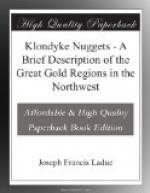“The Teslintoo[6] was so called by Dr. Dawson—this, according to information obtained by him, being the Indian name. It is called by the miners ‘Hootalinkwa’ or Hotalinqua, and was called by Schwatka, who appears to have bestowed no other attention to it, the Newberry, although it is apparently much larger than the Lewes. This was so apparent that in my interim reports I stated it as a fact. Owing to circumstances already narrated, I had not time while at the mouth to make any measurement to determine the relative size of the rivers; but on his way out Dr. Dawson made these measurements, and his report, before referred to, gives the following values of the cross sections of each stream: Lewes, 3,015 feet; Teslintoo, 3,809 feet. In the same connection he states that the Lewes appeared to be about 1 foot above its lowest summer level, while the Teslintoo appeared to be at its lowest level. Assuming this to be so, and taking his widths as our data, it would reduce his cross section of the Lewes to 2,595 feet. Owing, however, to the current in the Lewes, as determined by Dr. Dawson, being just double that of the Teslintoo, the figures being 5.68 and 2.88 miles per hour, respectively, the discharge of the Lewes, taking these figures again in 18,644 feet, and of the Teslintoo 11,436 feet. To reduce the Lewes to its lowest level the doctor says would make its discharge 15,600 feet.
[Footnote 6: The limited amount of prospecting that has been done on this river is said to be very satisfactory, fine gold having been found in all parts of the river. The lack of supplies is the great drawback to its development, and this will not be overcome to any extent until by some means heavy freight can be brought over the coast range to the head of the river. Indeed, owing to the difficulties attending access and transportation, the great drawback to the entire Yukon district at present is the want of heavy mining machinery and the scarcity of supplies. The government being aware of the requirements and possibilities of the country, has undertaken the task of making preliminary surveys for trails and railroads, and no doubt in the near future the avenue for better and quicker transportation facilities will be opened up.]
“The water of the Teslintoo is of a dark brown color, similar in appearance to the Ottawa River water, and a little turbid. Notwithstanding the difference of volume of discharge, the Teslintoo changes completely the character of the river below the junction, and a person coming up the river would, at the forks, unhesitatingly pronounce the Teslintoo the main stream. The water of the Lewes is blue in color, and at the time I speak of was somewhat dirty—not enough so, however, to prevent one seeing to a depth of two or three feet.




